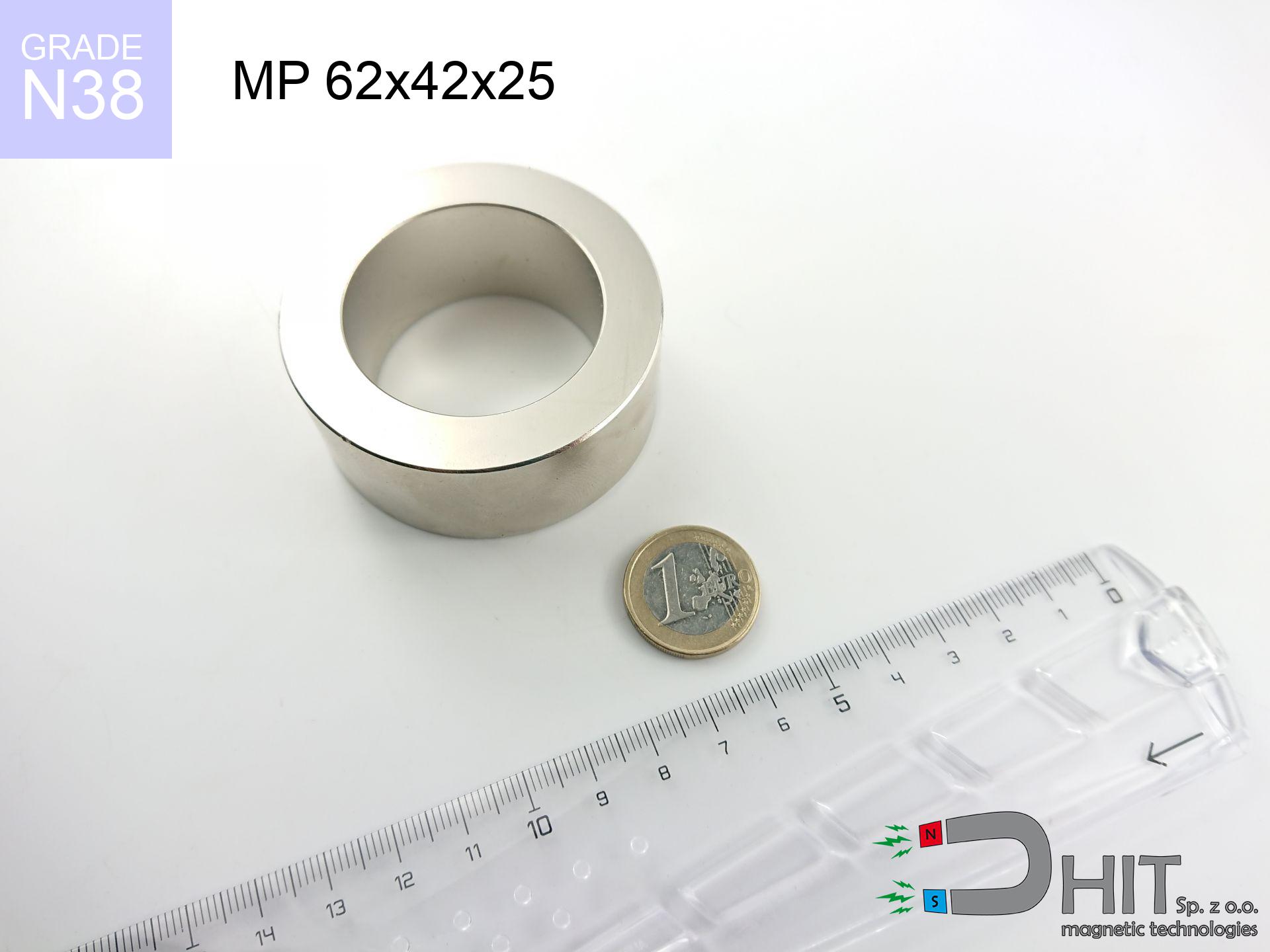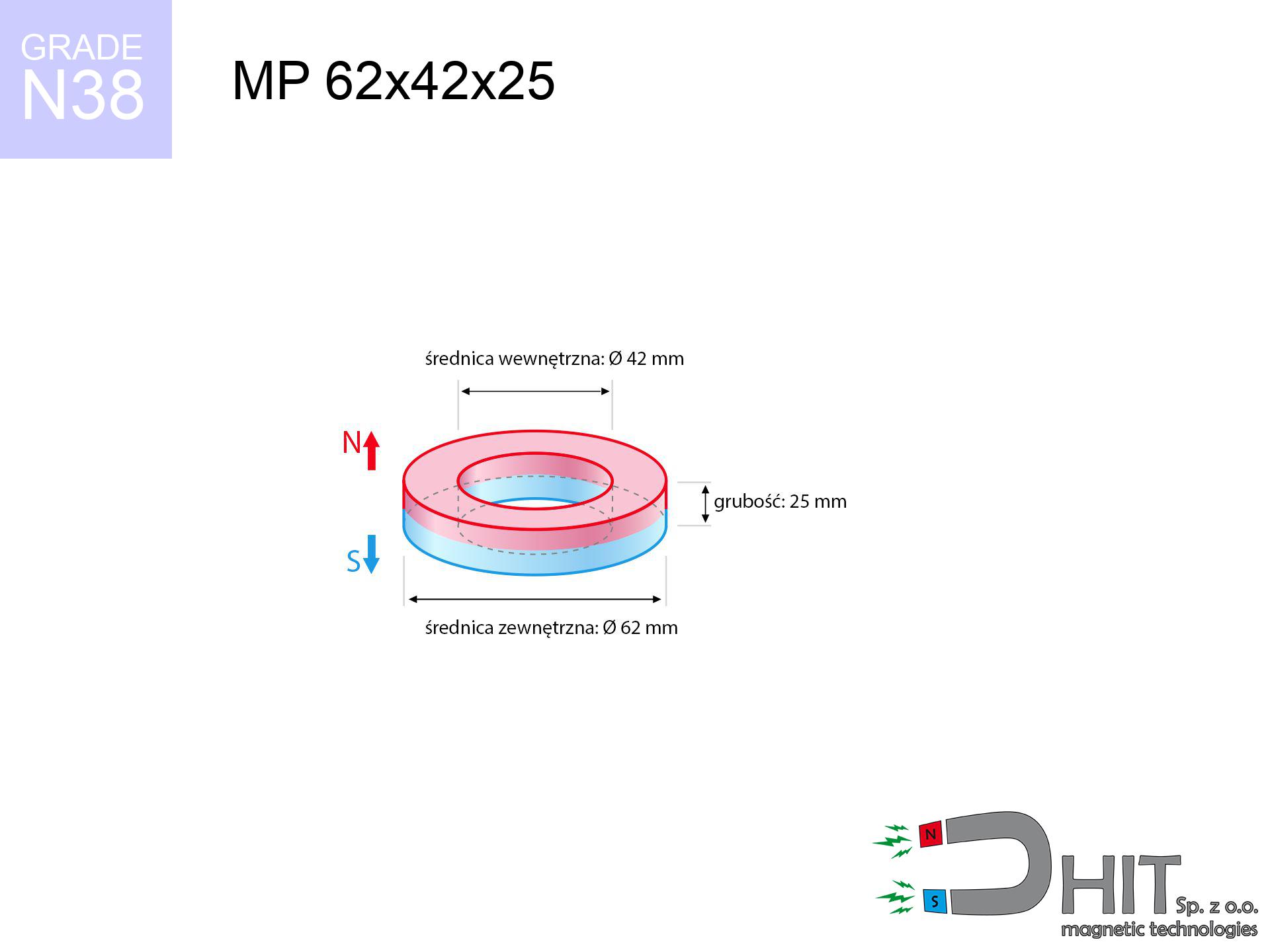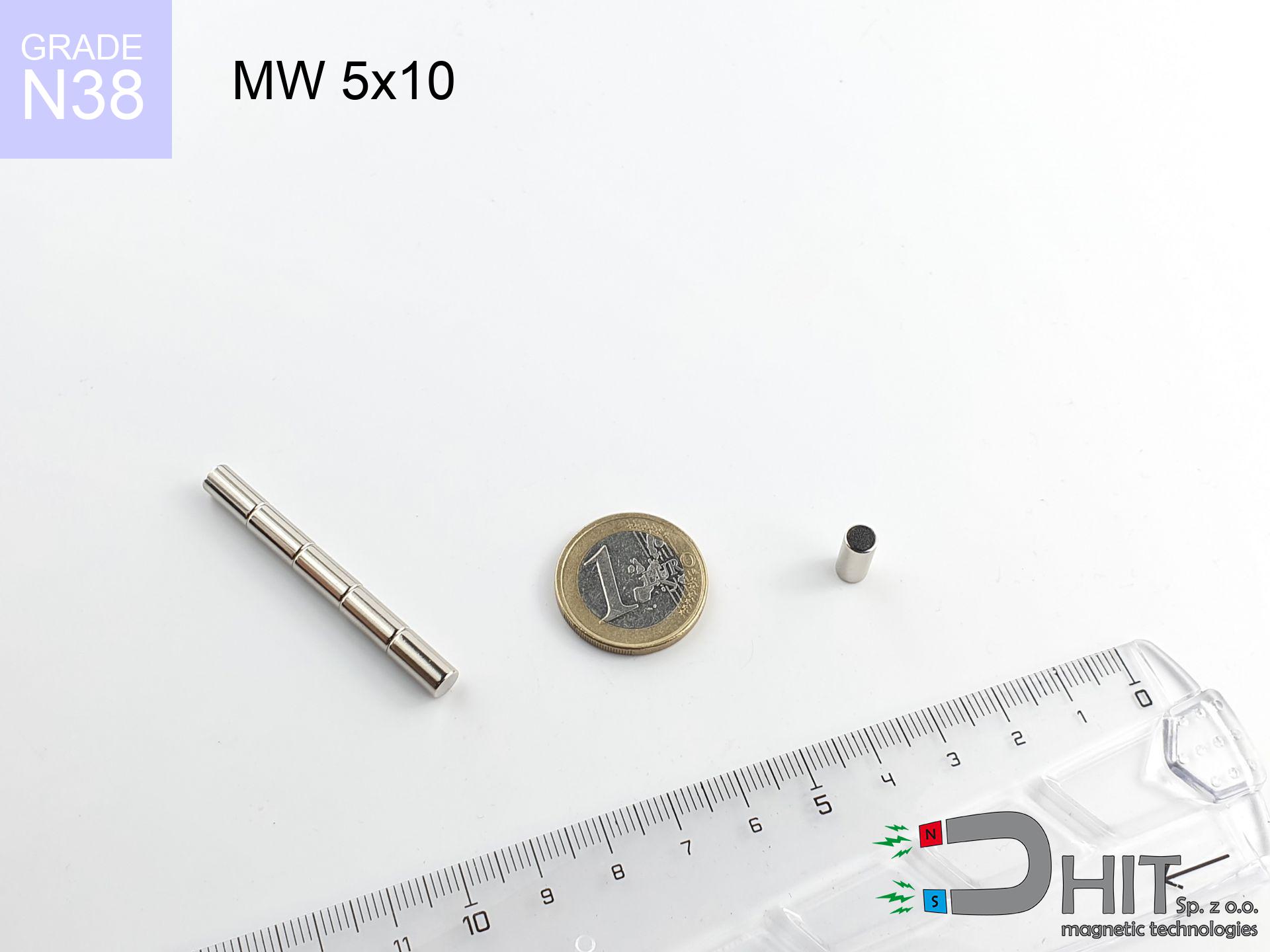MP 62x42x25 / N38 - ring magnet
ring magnet
Catalog no 030205
GTIN/EAN: 5906301812227
Diameter
62 mm [±0,1 mm]
internal diameter Ø
42 mm [±0,1 mm]
Height
25 mm [±0,1 mm]
Weight
306.31 g
Magnetization Direction
↑ axial
Load capacity
58.67 kg / 575.60 N
Magnetic Induction
389.14 mT / 3891 Gs
Coating
[NiCuNi] Nickel
165.00 ZŁ with VAT / pcs + price for transport
134.15 ZŁ net + 23% VAT / pcs
bulk discounts:
Need more?
Contact us by phone
+48 888 99 98 98
alternatively drop us a message using
inquiry form
through our site.
Force as well as shape of neodymium magnets can be estimated with our
magnetic mass calculator.
Same-day processing for orders placed before 14:00.
Technical data of the product - MP 62x42x25 / N38 - ring magnet
Specification / characteristics - MP 62x42x25 / N38 - ring magnet
| properties | values |
|---|---|
| Cat. no. | 030205 |
| GTIN/EAN | 5906301812227 |
| Production/Distribution | Dhit sp. z o.o. |
| Country of origin | Poland / China / Germany |
| Customs code | 85059029 |
| Diameter | 62 mm [±0,1 mm] |
| internal diameter Ø | 42 mm [±0,1 mm] |
| Height | 25 mm [±0,1 mm] |
| Weight | 306.31 g |
| Magnetization Direction | ↑ axial |
| Load capacity ~ ? | 58.67 kg / 575.60 N |
| Magnetic Induction ~ ? | 389.14 mT / 3891 Gs |
| Coating | [NiCuNi] Nickel |
| Manufacturing Tolerance | ±0.1 mm |
Magnetic properties of material N38
| properties | values | units |
|---|---|---|
| remenance Br [min. - max.] ? | 12.2-12.6 | kGs |
| remenance Br [min. - max.] ? | 1220-1260 | mT |
| coercivity bHc ? | 10.8-11.5 | kOe |
| coercivity bHc ? | 860-915 | kA/m |
| actual internal force iHc | ≥ 12 | kOe |
| actual internal force iHc | ≥ 955 | kA/m |
| energy density [min. - max.] ? | 36-38 | BH max MGOe |
| energy density [min. - max.] ? | 287-303 | BH max KJ/m |
| max. temperature ? | ≤ 80 | °C |
Physical properties of sintered neodymium magnets Nd2Fe14B at 20°C
| properties | values | units |
|---|---|---|
| Vickers hardness | ≥550 | Hv |
| Density | ≥7.4 | g/cm3 |
| Curie Temperature TC | 312 - 380 | °C |
| Curie Temperature TF | 593 - 716 | °F |
| Specific resistance | 150 | μΩ⋅cm |
| Bending strength | 250 | MPa |
| Compressive strength | 1000~1100 | MPa |
| Thermal expansion parallel (∥) to orientation (M) | (3-4) x 10-6 | °C-1 |
| Thermal expansion perpendicular (⊥) to orientation (M) | -(1-3) x 10-6 | °C-1 |
| Young's modulus | 1.7 x 104 | kg/mm² |
Physical modeling of the magnet - report
The following data represent the result of a mathematical analysis. Results rely on models for the class Nd2Fe14B. Actual performance might slightly deviate from the simulation results. Please consider these data as a supplementary guide when designing systems.
Table 1: Static pull force (force vs gap) - characteristics
MP 62x42x25 / N38
| Distance (mm) | Induction (Gauss) / mT | Pull Force (kg) | Risk Status |
|---|---|---|---|
| 0 mm |
4472 Gs
447.2 mT
|
58.67 kg / 58670.0 g
575.6 N
|
critical level |
| 1 mm |
4338 Gs
433.8 mT
|
55.21 kg / 55213.2 g
541.6 N
|
critical level |
| 2 mm |
4201 Gs
420.1 mT
|
51.77 kg / 51768.5 g
507.8 N
|
critical level |
| 3 mm |
4061 Gs
406.1 mT
|
48.39 kg / 48394.9 g
474.8 N
|
critical level |
| 5 mm |
3781 Gs
378.1 mT
|
41.94 kg / 41942.4 g
411.5 N
|
critical level |
| 10 mm |
3097 Gs
309.7 mT
|
28.15 kg / 28148.0 g
276.1 N
|
critical level |
| 15 mm |
2485 Gs
248.5 mT
|
18.12 kg / 18118.5 g
177.7 N
|
critical level |
| 20 mm |
1972 Gs
197.2 mT
|
11.41 kg / 11412.7 g
112.0 N
|
critical level |
| 30 mm |
1239 Gs
123.9 mT
|
4.51 kg / 4505.2 g
44.2 N
|
warning |
| 50 mm |
533 Gs
53.3 mT
|
0.83 kg / 832.4 g
8.2 N
|
low risk |
Table 2: Shear load (vertical surface)
MP 62x42x25 / N38
| Distance (mm) | Friction coefficient | Pull Force (kg) |
|---|---|---|
| 0 mm | Stal (~0.2) |
11.73 kg / 11734.0 g
115.1 N
|
| 1 mm | Stal (~0.2) |
11.04 kg / 11042.0 g
108.3 N
|
| 2 mm | Stal (~0.2) |
10.35 kg / 10354.0 g
101.6 N
|
| 3 mm | Stal (~0.2) |
9.68 kg / 9678.0 g
94.9 N
|
| 5 mm | Stal (~0.2) |
8.39 kg / 8388.0 g
82.3 N
|
| 10 mm | Stal (~0.2) |
5.63 kg / 5630.0 g
55.2 N
|
| 15 mm | Stal (~0.2) |
3.62 kg / 3624.0 g
35.6 N
|
| 20 mm | Stal (~0.2) |
2.28 kg / 2282.0 g
22.4 N
|
| 30 mm | Stal (~0.2) |
0.90 kg / 902.0 g
8.8 N
|
| 50 mm | Stal (~0.2) |
0.17 kg / 166.0 g
1.6 N
|
Table 3: Vertical assembly (sliding) - vertical pull
MP 62x42x25 / N38
| Surface type | Friction coefficient / % Mocy | Max load (kg) |
|---|---|---|
| Raw steel |
µ = 0.3
30% Nominalnej Siły
|
17.60 kg / 17601.0 g
172.7 N
|
| Painted steel (standard) |
µ = 0.2
20% Nominalnej Siły
|
11.73 kg / 11734.0 g
115.1 N
|
| Oily/slippery steel |
µ = 0.1
10% Nominalnej Siły
|
5.87 kg / 5867.0 g
57.6 N
|
| Magnet with anti-slip rubber |
µ = 0.5
50% Nominalnej Siły
|
29.34 kg / 29335.0 g
287.8 N
|
Table 4: Material efficiency (substrate influence) - power losses
MP 62x42x25 / N38
| Steel thickness (mm) | % power | Real pull force (kg) |
|---|---|---|
| 0.5 mm |
|
1.96 kg / 1955.7 g
19.2 N
|
| 1 mm |
|
4.89 kg / 4889.2 g
48.0 N
|
| 2 mm |
|
9.78 kg / 9778.3 g
95.9 N
|
| 5 mm |
|
24.45 kg / 24445.8 g
239.8 N
|
| 10 mm |
|
48.89 kg / 48891.7 g
479.6 N
|
Table 5: Working in heat (material behavior) - thermal limit
MP 62x42x25 / N38
| Ambient temp. (°C) | Power loss | Remaining pull | Status |
|---|---|---|---|
| 20 °C | 0.0% |
58.67 kg / 58670.0 g
575.6 N
|
OK |
| 40 °C | -2.2% |
57.38 kg / 57379.3 g
562.9 N
|
OK |
| 60 °C | -4.4% |
56.09 kg / 56088.5 g
550.2 N
|
OK |
| 80 °C | -6.6% |
54.80 kg / 54797.8 g
537.6 N
|
|
| 100 °C | -28.8% |
41.77 kg / 41773.0 g
409.8 N
|
Table 6: Two magnets (repulsion) - field collision
MP 62x42x25 / N38
| Gap (mm) | Attraction (kg) (N-S) | Repulsion (kg) (N-N) |
|---|---|---|
| 0 mm |
264.93 kg / 264931 g
2599.0 N
5 588 Gs
|
N/A |
| 1 mm |
257.19 kg / 257186 g
2523.0 N
8 812 Gs
|
231.47 kg / 231468 g
2270.7 N
~0 Gs
|
| 2 mm |
249.32 kg / 249322 g
2445.8 N
8 676 Gs
|
224.39 kg / 224389 g
2201.3 N
~0 Gs
|
| 3 mm |
241.51 kg / 241510 g
2369.2 N
8 539 Gs
|
217.36 kg / 217359 g
2132.3 N
~0 Gs
|
| 5 mm |
226.10 kg / 226103 g
2218.1 N
8 262 Gs
|
203.49 kg / 203493 g
1996.3 N
~0 Gs
|
| 10 mm |
189.40 kg / 189396 g
1858.0 N
7 562 Gs
|
170.46 kg / 170456 g
1672.2 N
~0 Gs
|
| 20 mm |
127.11 kg / 127106 g
1246.9 N
6 195 Gs
|
114.40 kg / 114395 g
1122.2 N
~0 Gs
|
| 50 mm |
32.28 kg / 32284 g
316.7 N
3 122 Gs
|
29.06 kg / 29056 g
285.0 N
~0 Gs
|
Table 7: Hazards (electronics) - warnings
MP 62x42x25 / N38
| Object / Device | Limit (Gauss) / mT | Safe distance |
|---|---|---|
| Pacemaker | 5 Gs (0.5 mT) | 32.5 cm |
| Hearing aid | 10 Gs (1.0 mT) | 25.5 cm |
| Timepiece | 20 Gs (2.0 mT) | 20.0 cm |
| Phone / Smartphone | 40 Gs (4.0 mT) | 15.5 cm |
| Car key | 50 Gs (5.0 mT) | 14.0 cm |
| Payment card | 400 Gs (40.0 mT) | 6.0 cm |
| HDD hard drive | 600 Gs (60.0 mT) | 5.0 cm |
Table 8: Collisions (cracking risk) - warning
MP 62x42x25 / N38
| Start from (mm) | Speed (km/h) | Energy (J) | Predicted outcome |
|---|---|---|---|
| 10 mm |
17.65 km/h
(4.90 m/s)
|
3.68 J | |
| 30 mm |
25.31 km/h
(7.03 m/s)
|
7.57 J | |
| 50 mm |
31.49 km/h
(8.75 m/s)
|
11.72 J | |
| 100 mm |
44.16 km/h
(12.27 m/s)
|
23.04 J |
Table 9: Surface protection spec
MP 62x42x25 / N38
| Technical parameter | Value / Description |
|---|---|
| Coating type | [NiCuNi] Nickel |
| Layer structure | Nickel - Copper - Nickel |
| Layer thickness | 10-20 µm |
| Salt spray test (SST) ? | 24 h |
| Recommended environment | Indoors only (dry) |
Table 10: Construction data (Pc)
MP 62x42x25 / N38
| Parameter | Value | SI Unit / Description |
|---|---|---|
| Magnetic Flux | 100 906 Mx | 1009.1 µWb |
| Pc Coefficient | 0.64 | High (Stable) |
Table 11: Submerged application
MP 62x42x25 / N38
| Environment | Effective steel pull | Effect |
|---|---|---|
| Air (land) | 58.67 kg | Standard |
| Water (riverbed) |
67.18 kg
(+8.51 kg Buoyancy gain)
|
+14.5% |
1. Shear force
*Note: On a vertical surface, the magnet retains just ~20% of its nominal pull.
2. Efficiency vs thickness
*Thin steel (e.g. 0.5mm PC case) drastically weakens the holding force.
3. Power loss vs temp
*For N38 material, the critical limit is 80°C.
4. Demagnetization curve and operating point (B-H)
chart generated for the permeance coefficient Pc (Permeance Coefficient) = 0.64
The chart above illustrates the magnetic characteristics of the material within the second quadrant of the hysteresis loop. The solid red line represents the demagnetization curve (material potential), while the dashed blue line is the load line based on the magnet's geometry. The Pc (Permeance Coefficient), also known as the load line slope, is a dimensionless value that describes the relationship between the magnet's shape and its magnetic stability. The intersection of these two lines (the black dot) is the operating point — it determines the actual magnetic flux density generated by the magnet in this specific configuration. A higher Pc value means the magnet is more 'slender' (tall relative to its area), resulting in a higher operating point and better resistance to irreversible demagnetization caused by external fields or temperature. A value of 0.42 is relatively low (typical for flat magnets), meaning the operating point is closer to the 'knee' of the curve — caution is advised when operating at temperatures near the maximum limit to avoid strength loss.
Elemental analysis
| iron (Fe) | 64% – 68% |
| neodymium (Nd) | 29% – 32% |
| boron (B) | 1.1% – 1.2% |
| dysprosium (Dy) | 0.5% – 2.0% |
| coating (Ni-Cu-Ni) | < 0.05% |
Environmental data
| recyclability (EoL) | 100% |
| recycled raw materials | ~10% (pre-cons) |
| carbon footprint | low / zredukowany |
| waste code (EWC) | 16 02 16 |
View more deals
Advantages as well as disadvantages of Nd2Fe14B magnets.
Advantages
- They retain magnetic properties for nearly ten years – the loss is just ~1% (according to analyses),
- They are noted for resistance to demagnetization induced by presence of other magnetic fields,
- Thanks to the metallic finish, the plating of nickel, gold-plated, or silver gives an aesthetic appearance,
- They show high magnetic induction at the operating surface, making them more effective,
- Made from properly selected components, these magnets show impressive resistance to high heat, enabling them to function (depending on their form) at temperatures up to 230°C and above...
- Considering the potential of precise forming and adaptation to unique needs, NdFeB magnets can be modeled in a broad palette of forms and dimensions, which amplifies use scope,
- Significant place in advanced technology sectors – they are commonly used in HDD drives, electric drive systems, diagnostic systems, also other advanced devices.
- Relatively small size with high pulling force – neodymium magnets offer impressive pulling force in compact dimensions, which enables their usage in miniature devices
Cons
- They are prone to damage upon too strong impacts. To avoid cracks, it is worth protecting magnets using a steel holder. Such protection not only shields the magnet but also improves its resistance to damage
- NdFeB magnets demagnetize when exposed to high temperatures. After reaching 80°C, many of them experience permanent drop of strength (a factor is the shape and dimensions of the magnet). We offer magnets specially adapted to work at temperatures up to 230°C marked [AH], which are extremely resistant to heat
- Due to the susceptibility of magnets to corrosion in a humid environment, we advise using waterproof magnets made of rubber, plastic or other material immune to moisture, when using outdoors
- We recommend a housing - magnetic holder, due to difficulties in creating threads inside the magnet and complicated shapes.
- Health risk resulting from small fragments of magnets pose a threat, if swallowed, which gains importance in the aspect of protecting the youngest. Additionally, small components of these devices can disrupt the diagnostic process medical after entering the body.
- Higher cost of purchase is a significant factor to consider compared to ceramic magnets, especially in budget applications
Pull force analysis
Detachment force of the magnet in optimal conditions – what it depends on?
- on a block made of structural steel, effectively closing the magnetic flux
- with a thickness minimum 10 mm
- with an polished touching surface
- with direct contact (no paint)
- during pulling in a direction vertical to the mounting surface
- in stable room temperature
Determinants of lifting force in real conditions
- Space between magnet and steel – every millimeter of separation (caused e.g. by varnish or dirt) significantly weakens the pulling force, often by half at just 0.5 mm.
- Pull-off angle – note that the magnet has greatest strength perpendicularly. Under sliding down, the holding force drops significantly, often to levels of 20-30% of the nominal value.
- Substrate thickness – for full efficiency, the steel must be sufficiently thick. Thin sheet restricts the attraction force (the magnet "punches through" it).
- Chemical composition of the base – low-carbon steel attracts best. Higher carbon content reduce magnetic properties and holding force.
- Base smoothness – the more even the plate, the better the adhesion and higher the lifting capacity. Roughness creates an air distance.
- Thermal conditions – neodymium magnets have a sensitivity to temperature. When it is hot they are weaker, and in frost gain strength (up to a certain limit).
Holding force was checked on a smooth steel plate of 20 mm thickness, when the force acted perpendicularly, in contrast under shearing force the load capacity is reduced by as much as 75%. Moreover, even a slight gap between the magnet and the plate decreases the lifting capacity.
Safety rules for work with neodymium magnets
Danger to the youngest
Product intended for adults. Tiny parts pose a choking risk, leading to severe trauma. Store away from kids and pets.
Finger safety
Watch your fingers. Two large magnets will snap together instantly with a force of massive weight, crushing everything in their path. Exercise extreme caution!
Magnets are brittle
Neodymium magnets are sintered ceramics, which means they are prone to chipping. Collision of two magnets leads to them shattering into small pieces.
Medical interference
Health Alert: Strong magnets can deactivate pacemakers and defibrillators. Do not approach if you have electronic implants.
Metal Allergy
Allergy Notice: The Ni-Cu-Ni coating contains nickel. If skin irritation appears, immediately stop working with magnets and use protective gear.
Threat to electronics
Equipment safety: Neodymium magnets can ruin payment cards and delicate electronics (pacemakers, medical aids, timepieces).
Dust explosion hazard
Powder generated during grinding of magnets is self-igniting. Avoid drilling into magnets without proper cooling and knowledge.
Keep away from electronics
A powerful magnetic field negatively affects the functioning of compasses in smartphones and navigation systems. Do not bring magnets close to a smartphone to avoid damaging the sensors.
Conscious usage
Before use, check safety instructions. Uncontrolled attraction can destroy the magnet or hurt your hand. Think ahead.
Do not overheat magnets
Monitor thermal conditions. Heating the magnet above 80 degrees Celsius will destroy its properties and pulling force.









